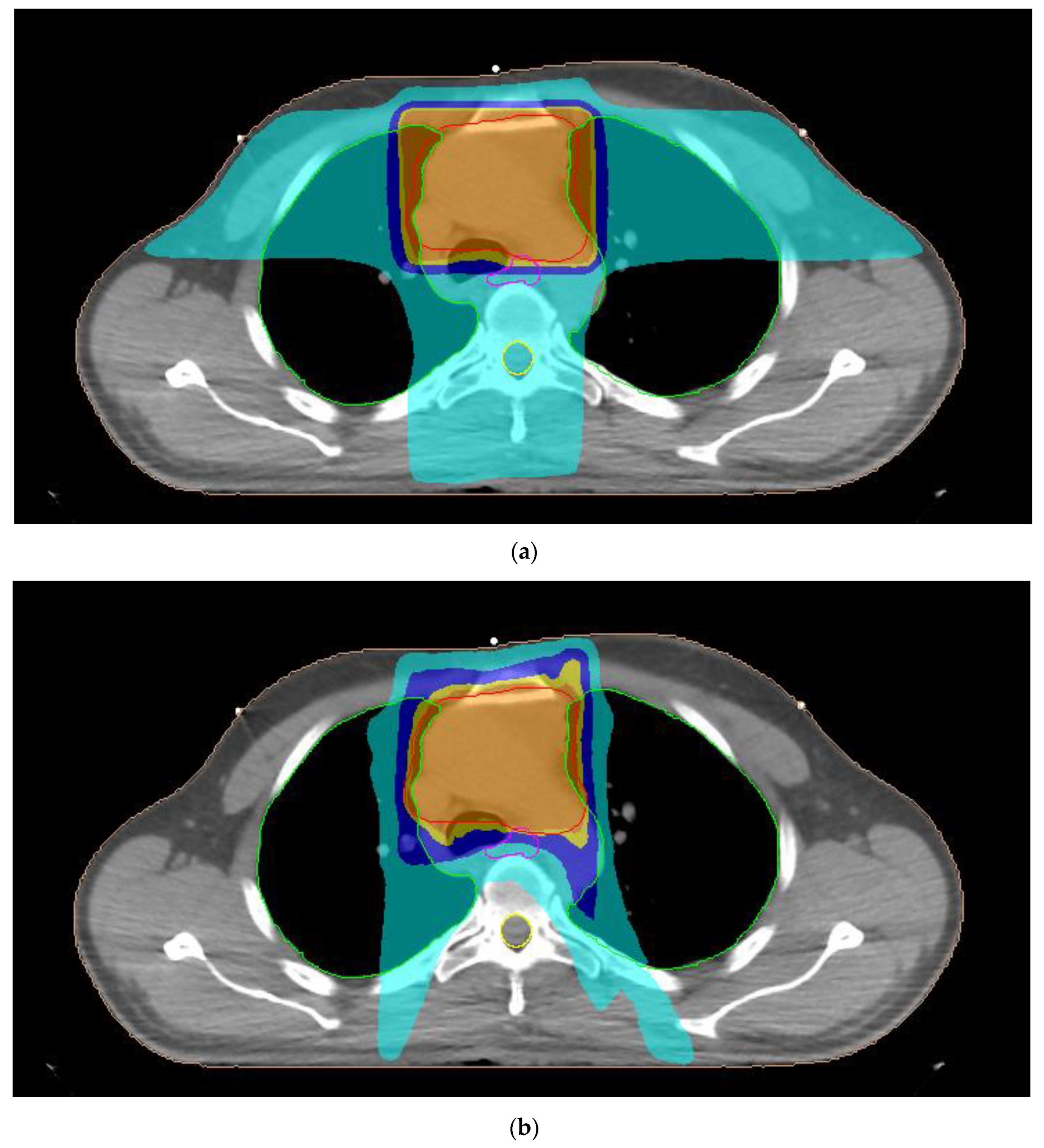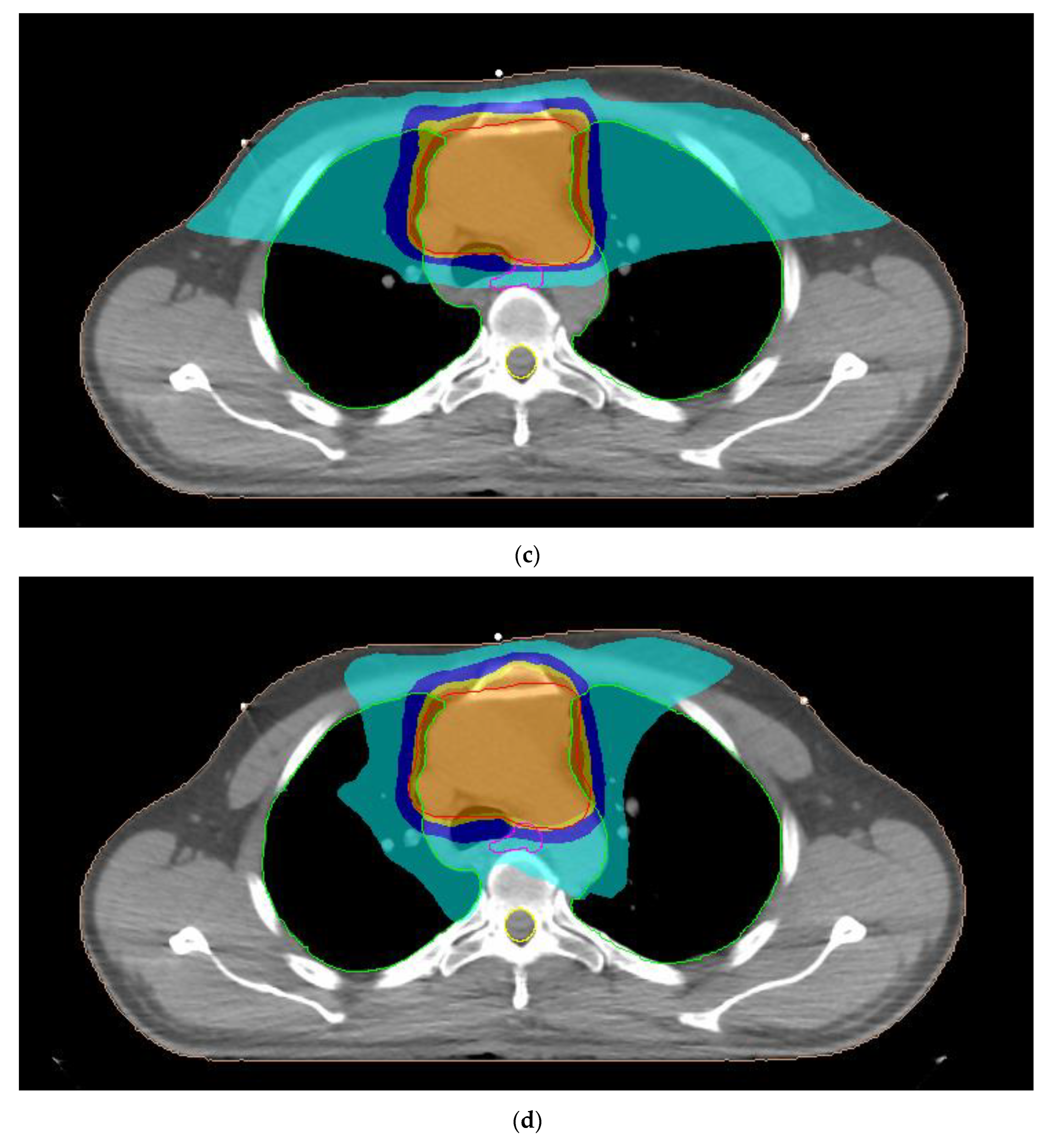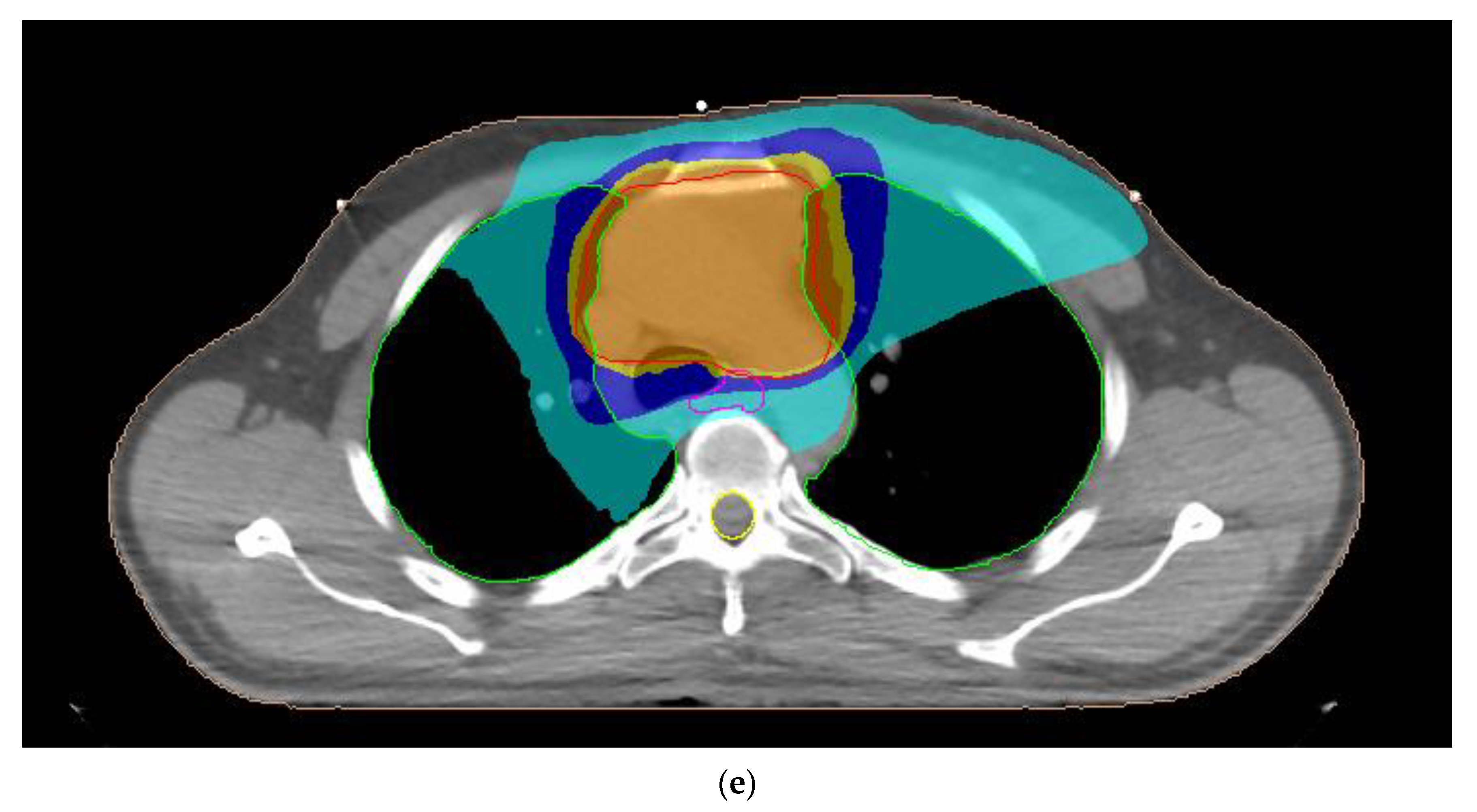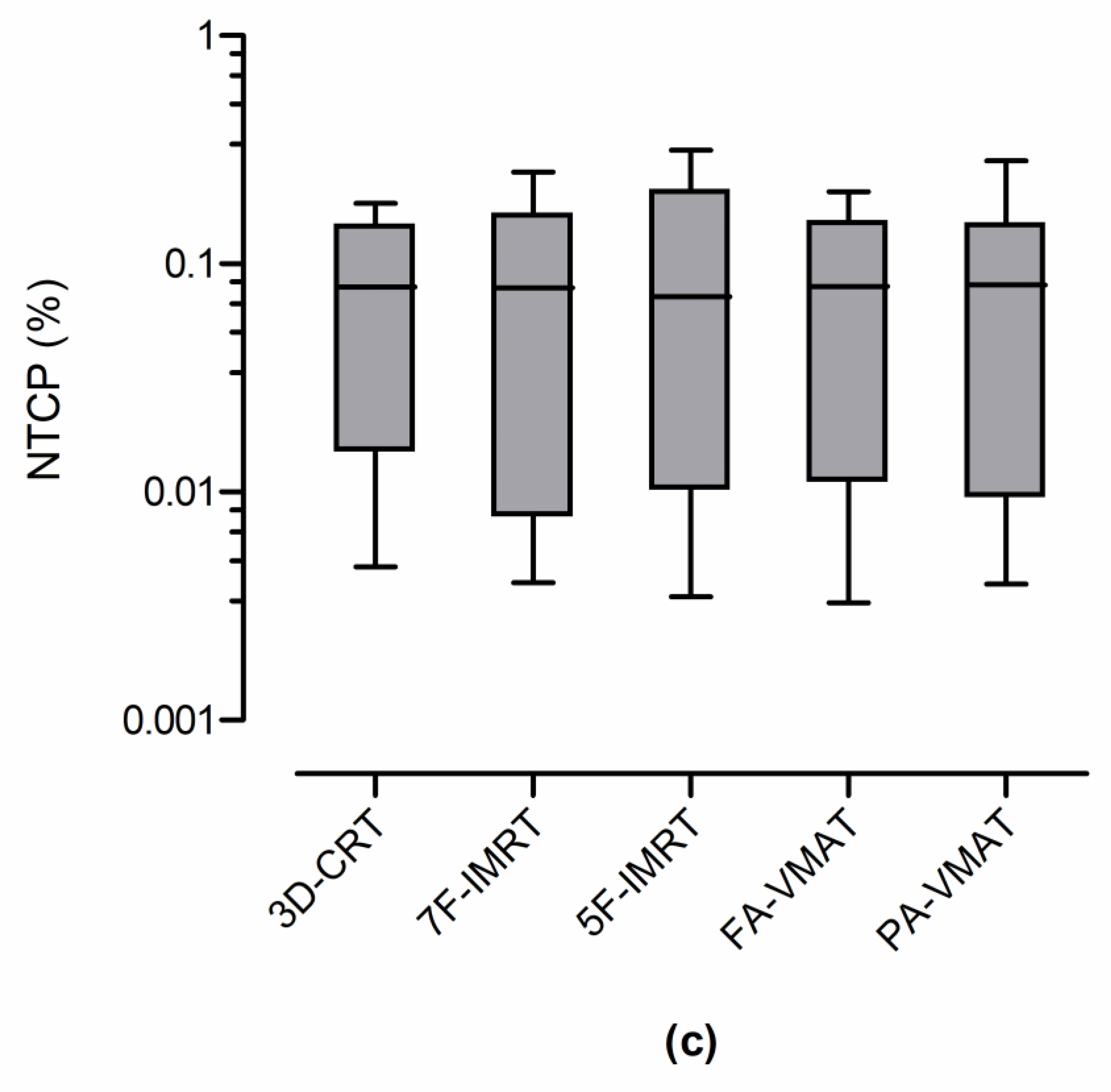1. Introduction
The epithelial tumors of the thymus gland include thymomas and thymic carcinomas. Most of these malignancies are thymomas mainly presented in the mediastinal region [
1]. Thymomas are rare tumors with an incidence of approximately 0.15 cases per 100,000 person-years [
2]. However, the thymomas are the most common malignant diseases in the anterior mediastinum [
1]. Radiotherapy plays a major role in the effective management of these tumors. The administration of radiation therapy is recommended for patients with unresectable disease or incompletely resected thymoma [
3]. Postoperative therapeutic irradiation may be also applied for subjects having a locally advanced disease [
3].
Thymomas are usually diagnosed in subjects aged 50 to 60 years old [
4]. The five-year survival rate of this malignancy has currently reached 90% [
3]. For these middle-aged cancer patients with the good prognosis, it is of great importance to ensure the minimization of complications related to radiation therapy. This type of treatment always involves high energy beams delivering high doses to the tumor site. Parts of the adjacent radiosensitive organs, such as lungs, esophagus and heart, often receive high doses increasing the probability of toxicity including pneumonitis, pericardial effusions and esophageal stricture [
5]. Patients with thymoma may be also subjected to an elevated risk for second cancer induction after treatment [
6].
The determination of toxicity through the direct follow-up of irradiated patients is a difficult long-term process because of the rarity of thymomas. Several studies have provided theoretical estimates of the complications associated with the external-beam radiotherapy [
7,
8,
9,
10,
11,
12,
13]. The vast majority of these reports were focused on the risk of radiation carcinogenesis [
7,
8,
9,
10,
12]. The literature lacks information on the non-cancer adverse effects of radiation. Moiseenko et al. estimated the normal tissue complication probability (NTCP) only for lungs irradiated using a
60Co unit or X-rays with energy of 18–25 MV [
11]. Computed tomography (CT) planning was performed only in 57% of the study participants. Yan et al. calculated the NTCP of the lungs and heart in patients with thymoma [
13]. Their calculations were restricted to a single irradiation approach. It is well known that the radiation exposure of each organ-at-risk (OAR) may vary by the irradiation technique [
5]. The variation of the organ-specific probability for toxicity by the applied treatment method needs to be investigated.
The aim of this study was to calculate the NTCPs of critical organs from three-dimensional conformal radiotherapy (3D-CRT), five-field intensity modulated radiation therapy (5F-IMRT), seven-field IMRT (7F-IMRT), full-arc volumetric modulated arc therapy (FA-VMAT) and partial-arc (PA) VMAT in patients with thymoma.
4. Discussion
Five different irradiation techniques for thymoma, including the conventional 3D-CRT and the advanced 5F-IMRT, 7F-IMRT, PA-VMAT and FA-VMAT, were compared in this study. A four-field arrangement was used for generating the plans with the 3D-CRT technique. Similar field configurations comprising three to five beams have been employed during conformal treatment of thymoma [
10,
19]. Two-dimensional and 3D radiation techniques based on a simple arrangement with two anteroposterior and posteroanterior opposed beams have also been applied for treating thymic tumors [
5,
10].
All generated treatment plans satisfied the dose constraints for the lungs, heart, esophagus and spinal cord. They also provided the required dose coverage to the target volume. Both IMRT and VMAT systematically led to a better dose homogeneity and conformity within the target in respect to 3D-CRT. A superior target coverage was also observed with the modern intensity modulated techniques. All fifty-five generated treatment plans satisfied the dose constraints for the OARs and they were considered acceptable for clinical use. The IMRT and VMAT plans reduced the Dav of the esophagus, the Dmax of the spinal cord, the V20Gy of the lungs and the dose parameters of the heart compared to the values derived from the 3D-CRT. The 3D-CRT resulted in lower V5Gy of the lungs than that from the intensity-modulated techniques. Similar average lung doses and V50Gy values for esophagus were observed between the five irradiation techniques.
Small differences were found in the dose parameters of the PTV and OARs as derived from the treatment plans generated with the four advanced intensity-modulated techniques. For example, the TC and HI calculated by the PA-VMAT plans were slightly better than those from FA-VMAT, although the two techniques led to the same CN value. A small increase in V20Gy and V5Gy of the lungs from FA-VMAT in respect to the parameters associated with PA-VMAT was observed. The opposite result was found for the average cardiac dose and the parameter V30Gy of the heart. The above differences could be attributed to several factors related to the application of the specific dose constraints for generating the IMRT and VMAT plans, the selection of the beam configuration for each technique and the performance of the optimization algorithms employed for the process of treatment planning.
Yan et al. used the 7F-IMRT free-breathing techniques with 3 mm internal target volume margin [
13]. They reported a D
av of the lungs and esophagus of 10.28 and 17.54 Gy, respectively. These values are similar to those found in our group of patients. However, they gave a D
av of the heart of 15.90 Gy which is higher than that presented here. Our dose results were much lower than those given by Haefner et al. [
19]. They reported that the D
av of the lungs, heart and esophagus from 3D-CRT plans was equal to 26.91, 24.76 and 36.19 Gy, respectively. The corresponding doses from VMAT were 21.57, 17.08 and 28.75 Gy. The results of the current study were elevated compared to those derived from the IMRT and VMAT plans in the work of He et al. [
23]. They gave a D
av of the lungs, heart and esophagus of up to 9.33, 5.56 and 15.12 Gy. A wide variation in the D
max of the spinal cord from 6.33 Gy to 60.63 Gy due to the use of 3D-CRT, IMRT and VMAT in patients with thymoma has been reported in the literature [
13,
19,
23]. The corresponding spinal dose in our study reached 17.9 Gy with static and rotational intensity modulated radiotherapy and was 30.6 Gy with conventional conformal treatment. It should be noted that the dosimetric data of the above previous studies corresponded to a stable target dose of 50 Gy [
13,
19,
23]. Our results were taken with PTV doses from 50.4 to 59.4 Gy depending onthe patient’s disease stage.
The evaluation of radiation therapy plans should not be based only on dosimetric analysis but also on the determination of radiobiological indices [
24,
25]. In the present study, the NTCPs of the lungs, heart and esophagus due to thymoma irradiation were calculated in terms of pneumonitis, pericarditis and perforation or stricture, respectively. These calculations were made on the basis of the EUD determined with the aid of the Niemierko model [
20,
21]. The NTCPs of the esophagus and heart calculated from DVHs obtained by the five treatment techniques were found to be rather small. The average NTCP of the heart was 0.06% for 3D-CRT and reduced to 0.03–0.04% for IMRT and VMAT. The corresponding average values for esophagus were 0.08–0.10%. It should be mentioned that the maximum NTCP value for the heart was 0.36% for a patient with thymoma subjected to 3D-CRT, whereas that for esophagus reached 0.31% during IMRT with a five-field arrangement. The average NTCP of the lungs varied from 0.34% to 0.49% by the treatment method applied for the management of thymoma. These values were higher than those for heart and esophagus. The NTCP of the lungs exceeded 1% only in two patients due to the large dimensions of the target resulting in a heavy radiation exposure of these critical structures. The relatively increased NTCPs of the lungs should not be ignored by radiation oncologists and medical physicists in the process of treatment planning for thymomas.
The patient-specific NTCPs were statistically compared for the three examined OARs between the five different radiation therapy techniques. Some of these comparisons led to significant differences for the radiosensitive lungs and heart (p < 0.05). The NTCPs of the heart from 3D-CRT were significantly increased than those derived from 5F-IMRT, 7F-IMRT, FA-VMAT and PA-VMAT. Moreover, the 7F-IMRT significantly reduced the NTCP of the lungs compared to FA-VMAT. A similar considerable decrease was found when 5F-IMRT was used instead of the PA-VMAT. Insignificant NTCP differences between the treatment techniques were found for the esophagus.
This study may be limited by the relatively low number of participants irradiated for thymoma. This was due to the rarity of this malignant disease [
2]. The current work compared radiobiological parameters calculated from five photon radiotherapy techniques which may be applied in patients with thymoma. Hardron therapy may also be employed for the management of thymic epithelial tumors [
26]. Further research is needed to compare the NTCP values presented here with those from proton and carbon ion therapy.










